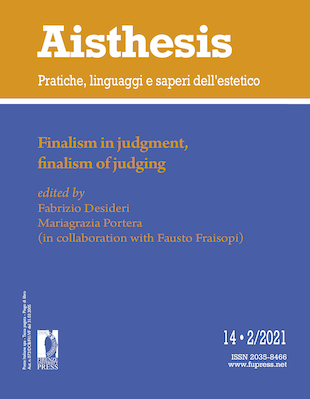Published 2021-12-30
How to Cite
Abstract
What does it mean to “judge” something? What are the preconditions and the necessary prerequisites for the formulation of a judgement (be it a cognitive judgement, a moral judgement, or an aesthetic judgement)? Is there a special relationship between finalism and judgement and, if yes, in what sense? The relationship between finalism and judgment has been typically understood along two main lines of interpretation: on the one hand, as the finalism attributed by judging to certain objects or phenomena; on the other hand, from the point of view of the finality of judging itself, i.e., the teleological orientation of judging in the global dimension of life.
This issue of Aisthesis includes a selection of highly relevant contributions to the topic “Judgement and finalism”, with the aim of bringing to the fore the circular movement that seems to characterize every judgement in itself – from nature, and from the nature of our mind, to the objects, structures, natural kinds etc. that populate the world, and reversely from the world to the mind. Kant’s Critique of the Power of Judgement plays, in this respect, a very fundamental role, as the papers by Stefano Velotti, Luigi Filieri, Lorenzo Sala, and Antonio Branca show brilliantly. Andrea Lanza and Barbara Santini discuss the interconnections between teleology and judgement in the frame, respectively, of Husserl’s phenomenology and Friedrich Hölderlin’s poetic philosophy. The idea that finalism and the dynamics of judgement have much to do with each other opens new links to disciplines other than philosophy and to an interdisciplinary approach to the activity of judging in research fields such as psychology, cognitive sciences, biology. This is the perspective adopted by Francesco Vitale, in his paper on Ernst Mayr’s teleonomy, and by Onerva Kiianlinna, in her a paper on epigenesis and modularity in Evolutionary Aesthetics.
This present issue is further enriched by a substantial focus on images and the aesthetic experience in the digital age (Fabrizio Desideri, Francesca Perotto, Caterina Zaira) and by a multifaceted and intriguing “Varia” section, with contributions by Ricardo Ibarlucia, Mariya Veleva, David Alvaro Gonzàlez, Carmelo Colangelo.


